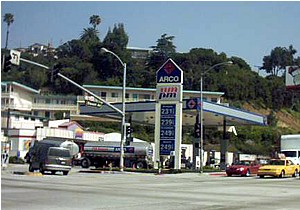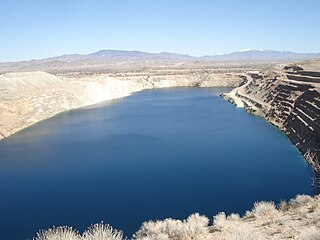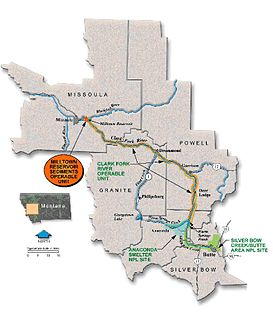
Atlantic Richfield Company is an American oil company with operations in the United States, Indonesia, the North Sea, the South China Sea, and Mexico. It has more than 1,300 gas stations in the western part of the United States, and recently five gas stations at northwestern Mexico. ARCO was formed by the merger of East Coast–based Atlantic Refining and California-based Richfield Oil Corporation in 1966. A merger in 1969 brought in Sinclair Oil Corporation. It became a subsidiary of UK-based BP plc in 2000 through its BP West Coast Products LLC (BPWCP) affiliate. On August 13, 2012, it was announced that Tesoro would purchase ARCO and its refinery for $2.5 billion. However, the deal came under fire due to increasing fuel prices. Many activists urged state and federal regulators to block the sale due to concerns that it would reduce competition and could lead to higher fuel prices at ARCO stations. On June 3, 2013, BP sold ARCO and the Carson Refinery to Tesoro for $2.5 billion. BP sold its Southern California terminals to Tesoro Logistics LP, including the Carson Storage Facility. BP will continue to own the ampm brand and sell it to Tesoro for Southern California, Arizona, and Nevada. BP exclusively licensed the ARCO rights from Tesoro for Northern California, Oregon, and Washington.

Marcus Daly was an Irish-born American businessman known as one of the three "Copper Kings" of Butte, Montana, United States.

Superfund is a United States federal government program designed to fund the cleanup of sites contaminated with hazardous substances and pollutants. Sites managed under this program are referred to as "Superfund" sites. It was established as the Comprehensive Environmental Response, Compensation, and Liability Act of 1980 (CERCLA). It authorizes federal natural resource agencies, primarily the Environmental Protection Agency (EPA), states and Native American tribes to recover natural resource damages caused by hazardous substances, though most states have and most often use their own versions of CERCLA. CERCLA created the Agency for Toxic Substances and Disease Registry (ATSDR). The EPA may identify parties responsible for hazardous substances releases to the environment (polluters) and either compel them to clean up the sites, or it may undertake the cleanup on its own using the Superfund and costs recovered from polluters by referring to the U.S. Department of Justice.

ASARCO LLC is a mining, smelting, and refining company based in Tucson, Arizona, which mines and processes primarily copper. The company is a subsidiary of Grupo México.

Anaconda, county seat of Deer Lodge County, which has a consolidated city-county government, is located in southwestern Montana of the United States. Located at the foot of the Anaconda Range, the Continental Divide passes within 8 mi (13 km) south of the community. As of the 2010 census the population of the consolidated city-county was 9,298, with a per capita personal income of $20,462 and a median household income of $34,716. It had earlier peaks of population in 1930 and 1980, based on the mining industry. It is still the ninth most populous city in Montana. Central Anaconda is 5,335 ft (1,626 m) above sea level, and is surrounded by the communities of Opportunity and West Valley.
After World War II, Montrose Chemical Corporation of California, 20201 S. Normandie Ave., Unincorporated LA County, California began producing Dichloro-Diphenyl-Trichloroethane (DDT), the new "wonder pesticide". Its waste disposal system funneled the plant’s processed waste into the county sewer system and ultimately into the ocean. Montrose continued producing DDT even in the face of increasing scientific concerns about DDT in the 1960s. Production did not stop until 1982. The site discharged an estimated 1,700 tons of DDT between the late 1950s and early 1970s alone, which contaminated ocean sediments on the floor of the Palos Verdes Shelf (PVS) near Los Angeles, California.

In 1990, the Allied Paper, Inc./Portage Creek/Kalamazoo River in southwestern Michigan was declared by the Environmental Protection Agency (EPA) to be a Superfund site – in other words, an abandoned industrial site containing significant amounts of toxic waste. The EPA and companies responsible for the waste in this area, which includes a three-mile section of Portage Creek as well as part of the Kalamazoo River, into which it flows, are currently involved in an effort to reduce the amount of toxic waste at the site, which is contaminated by PCBs from paper mills and other factories.

The Anaconda Copper Mine is an open pit copper mine in Lyon County, Nevada that was owned and operated by the Anaconda Mining Company. It is located adjacent to the town of Yerington. A company town, Weed Heights, was built to support the mining operation which ran from 1952 until 1978.

In 1944, uranium mining under the U.S military's Manhattan Project began on Navajo Nation lands and on Lakota Nation lands. On August 1, 1946, the responsibility for atomic science and technology was transfered from the military to the United States Atomic Energy Commission. Afterward, widespread uranium mining began on Navajo and Lakota lands in a nuclear arms race with the Soviet Union during the Cold War.

Leviathan Mine is a United States superfund site at an abandoned open-pit sulfur mine located in Alpine County, California. The mine is located on the eastern slope of the Sierra Nevada at about 7,000-foot (2,100 m) elevation, 6 miles (9.7 km) east of Markleeville and 24 miles (39 km) southeast of Lake Tahoe. The mine site comprises approximately 250 acres (100 ha) of land surrounded by the Toiyabe National Forest, which is only accessible a few months a year. The approximately 22 million tons of sulfur ore-containing crushed rock at the mine are responsible for contaminating the Leviathan and Aspen Creek, which join with Mountaineer Creek to form Bryant Creek which ultimately empties into the East Fork of the Carson River. These water bodies are listed as 303(d) impaired. The site location is seismically active.
Rimini, ['rɪm ə naj] Montana is a ghost town which is one of the oldest mining districts in the state. It was established when silver lodes were discovered in 1864. Other names for the town were Lewis and Clark, Tenmile, Vaughn, Colorado, and Bear Gulch. It was the site of Camp Rimini, which trained dogs for use in World War II.

The Eagle Mine is an abandoned mine near the abandoned town of Gilman and about one mile south east of Minturn in the U.S. state of Colorado.

Silver Bow Creek is a 26-mile-long (42 km) headwater stream of the Clark Fork (river) originating within the city limits of Butte, Montana, from the confluence of Little Basin and Blacktail Creeks. A former northern tributary, Yankee Doodle Creek, no longer flows directly into Silver Bow Creek as it is now captured by the Berkeley Pit. Silver Bow Creek flows northwest and north through a high mountain valley, passing east of Anaconda, Montana, where it becomes the Clark Fork (river) at the confluence with Warm Springs Creek.

Butte is a city in southwestern Montana established as a mining camp in the 1860s in the northern Rocky Mountains straddling the Continental Divide. Butte became a hotbed for silver and gold mining in its early stages, and grew exponentially upon the advent of electricity in the late-nineteenth century due to the land's large natural stores of copper. In 1888 alone, mining operations in Butte had generated an output of $23 million. The arrival of several magnates in the area around this time, later known as the "Copper Kings," marked the beginning of Butte's establishment as a boomtown.
















